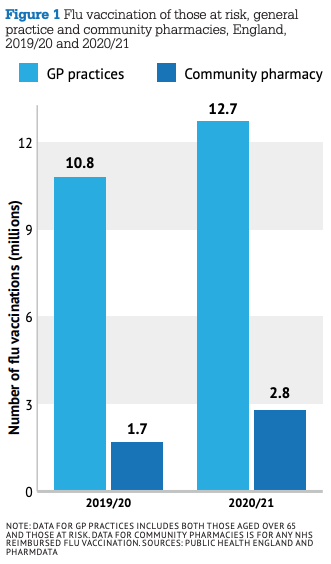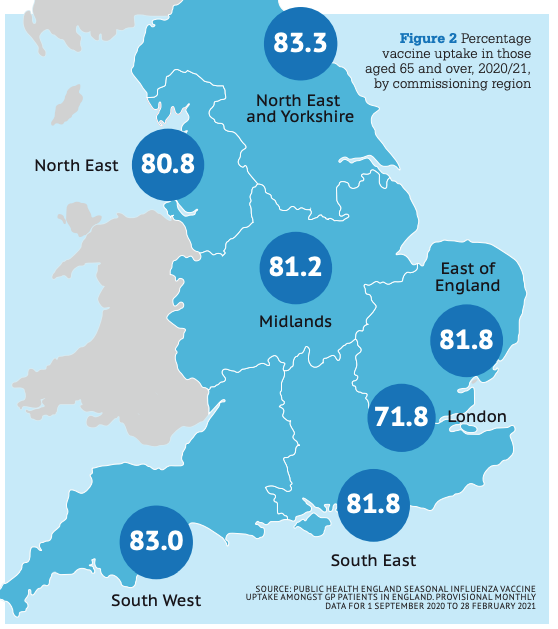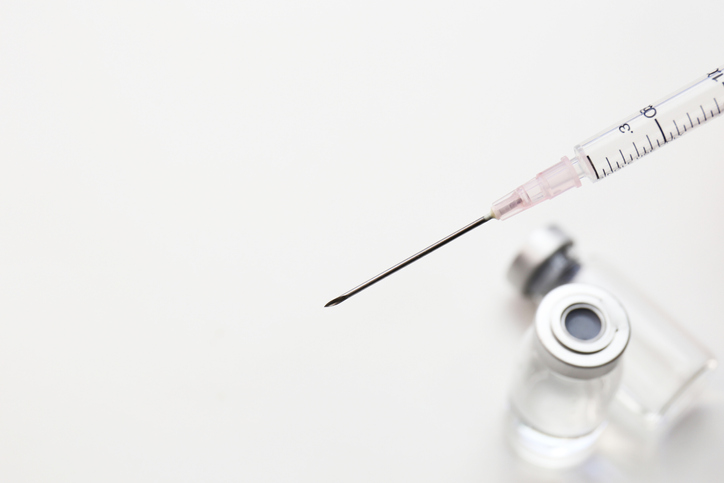Flu jab clawbacks suggest a new approach for PQS is required
In Services Development
Follow this topic
Bookmark
Record learning outcomes
By Leela Barham
NHS England and NHS Improvement (NHSE&I) say the Pharmacy Quality Scheme1 (PQS, originally the Quality Payments Scheme, QPS) was “designed to reward community pharmacies for delivering quality criteria in all three of the quality dimensions: clinical effectiveness, patient safety and patient experience.” So far, so laudable.
But in November 2021 the NHS Business Services Authority (NHSBSA) wrote to some community pharmacies informing them they intended to ‘claw back’ payments because the primary care network (PCN) where they work had failed to meet target flu vaccination rates in the 2020/21 flu season.
This looks perverse. Amit Patel, chief executive officer of Pharmacy London, and Merton, Sutton & Wandsworth and Croydon LPCs, puts it in stronger terms; “it’s a real kick in the teeth for community pharmacy.”
Incentives matter
The underpinning logic that you get what you pay for is evident in the PQS but it gets a little hazy once you go beyond the top level. The total value of the Scheme in 2019/202 was £75million – not all that much per pharmacy when shared across the network in England – with the actual amount any community pharmacy could receive based on accruing points across a number of domains.
Points are of variable value, with the variation reflecting the potential for different levels of performance and a desire to cap the total that could be paid out in a year. This already dilutes the incentive; community pharmacies will know that they’ll get something for a point, but not how much until after the year has passed and all the number crunching has been done.
With the Covid-19 pandemic ongoing, the 2020/21 PQS was split into two parts, but was still worth £75 million. The first part was focused on responding to the pandemic. The second part included infection prevention and control and antimicrobial stewardship, prevention, risk management and, under PCN domains, flu vaccination as well as business continuity. For 2020/21 the value of a point for Part 2 of the PQS was £53.88, with declarations having to be made by community pharmacies by 1 March 2021.
Encouraging flu vaccination delivery
When it comes to the PQS there are incentives for community pharmacies to deliver seasonal flu vaccination. One of the gateway criteria for any PQS payment in 2019/20 was to offer either the New Medicines Service (NMS) and/or flu vaccination to those at-risk, as set out in NHSE&I guidance3.
The incentive to deliver flu vaccination was then strengthened in 2020/21 through the addition of a new PCN domain that covered it. PQS payments were dependent on community pharmacies engaging with their PCN pharmacy lead to let them know they’d like to be involved in increasing the uptake of flu vaccination to patients aged 65 and over for the 2020/21 flu season. PCNs are, of course, still new, being formally established in July 2019, so this does presume that a PCN pharmacy lead has been appointed, and that pharmacies know who they are.
Collaboration is also part of the deal, with the PCN pharmacy lead needing to engage with all the community pharmacies in the PCN and agree how to work with general practice, as well as needing to engage with the PCN clinical director, according to guidance from the Pharmaceutical Services Negotiating Committee (PSNC).
Success is not just down to the community pharmacy; there was a target set for the PCN of achieving 70.1 per cent for flu vaccination of those aged 65 and over for the 2020/21 season. ‘Proof’ would come from the number of vaccines community pharmacy delivered to all eligible patients between 1 September and 31 January 2021. More points were available the higher the vaccination achievement up to delivering vaccination to 77 per cent of those aged 65 or over.
By 14 December, community pharmacies in England had delivered more than 4.6 million flu vaccinations in the 2021/22 season
What that means is that any community pharmacy wanting to earn points under this part of PQS in 2020/214 had no choice but to hitch their wagon to the PCN and therefore its overall performance. “We find ourselves having to depend upon how other parts of the system are performing,” Amit Patel points out. That might be a good thing in a fully functioning system, but PCNs were still relatively new; communication between the various participants in a PCN are variable, even today; co-ordinating service delivery across different professional groups feels like a stretch.

It’s also unclear how the 70.1 per cent target was set. It’s below the ambition of 75 per cent set out by the Department of Health and Social Care, Public Health England and the NHS5. It was a nationwide target too. There was no opportunity either to flex the 70.1 per cent depending upon any local issues such as supply of flu vaccines, issues which are not within the control of an individual community pharmacy. Amit Patel explains, “all community pharmacies were stuck with the PCN target. It was just arbitrary.”
Bringing this up to date, the 2021/22 PQS6 retains the focus on vaccinating those aged 65 and over against flu. Just as in 2020/21, engagement and collaboration between the PCN pharmacy lead and the PCN is required. The target has gotten tougher; it’s set at 80.1 per cent for the 2021/22 season; a minimum requirement of vaccinating 30 people was included too.
Record breaking delivery
Flu vaccination in general has gone up in recent years and perhaps that’s no surprise against the backdrop of the pandemic. Both GP practices and community pharmacies in England have seen a boost in uptake (Figure 1, above)7. In 2020/21 80.9 per cent of those aged 65 and over had a flu vaccination according to Public Health England, beating the target of 75 per cent and the highest it’s been in the last decade (the previous all-time high was 74 per cent back in 2011/12)8.
But it’s community pharmacy that has seen the biggest proportionate rise; racking up a 63 per cent increase in 2020/21 compared to the previous year, versus an 18 per cent increase seen in GP practices.

In other bad news for pharmacy, there is always variation across the country. London has performed less well compared to other parts of the country, at least when looking at commissioning regions and their constituent STPs (Figure 2, right).
By contrast however, flu vaccination for the current season is going extremely well. By 14 December, community pharmacies in England had delivered more than 4.6 million flu vaccinations in the 2021/22 season.
Add in Aspiration payments
The incentives get even more hazy with the link made between ‘Aspiration’ payments and activity delivered. In 2020/21 community pharmacies were able to claim an early and advanced Aspiration payment, designed to assist with cashflow and claimable between 14 September and 9 October 2020, with a reconciliation happening later.
It’s a complicated calculation, but in essence a pharmacy could claim for 70 per cent of the total points they expected to get, with the payment set at £48 a point, the minimum possible value of a point once all the calculations are made.
Deductions from payments to community pharmacies were therefore a possibility. This could happen when an Aspiration payment was more than what was due, based on what was delivered in practice. PCNs were able to challenge the data underpinning the calculations according to the PSNC, but no mention is made for community pharmacy to be able to do the same.
Claiming for an Aspiration payment was optional.
Fairness matters too
Money matters, but fairness matters too. Community pharmacies receiving clawback letters for the PCN failing to meet the target for over 65 flu vaccinations in 2020/21 exposes how the PQS allows community pharmacies to face a penalty, even if they’ve done everything that they could to increase flu vaccination.
Statistics that are available at commissioning region level – data by PCN is not – suggest that on average, even the lowest performance (in London) was still above the 70.1 percent target, including vaccinations delivered by general practice and community pharmacies. Cold comfort too that clawbacks are happening just when community pharmacy is smashing records for flu vaccinations in 2021/22. “Just when community pharmacies are hitting new highs for flu vaccinations, some community pharmacies are being told about claw backs from performance from last year,” says Mr Patel.
PSNC’s guidance makes it clear that the data on the percentage of the target population vaccinated by all the players in a PCN was not going to be available until after community pharmacy’s declaration had to be made. So not only do some community pharmacies face a penalty, they would have had no way of knowing that the PCN was not on target until after it’s been missed. As Amit Patel explains, “we’ve never had PCN level data. I’ve asked for how PCNs have been doing, but been told nothing until the letters came out about the clawback.” Little opportunity then to go back and collaborate some more and work out what could be done to remedy any shortfall.
Just when community pharmacies are hitting new highs... some are being told about claw backs from performance from last year
It seems perverse that after community pharmacy has collectively seen such success in delivering flu vaccinations that some are facing clawbacks. Even more at just the time that community pharmacy needs to be working even harder to deliver both flu and Covid-19 jabs, and especially given the most recent announcements about the Covid booster programme, still only available from a limited number of community pharmacies in England. Poor judgement is perhaps the most charitable way to describe the decision to write to community pharmacies in November to let them know that money is going to be clawed back from last year.
This may have been one of those cases where flexibility on the commissioner side – and dropping the clawback – would have proven to be the wiser investment. The example letter shared with P3pharmacy doesn’t even provide any clues as to how far below the target the PCN was when all the figures were in, so it’s unclear if the target of 80.1 per cent for 2021/22 is within reach to pharmacies in that PCN or not. That could dampen enthusiasm amongst even the most dedicated pharmacies. Now isn’t the time to make it less attractive to do this vital work.
Lessons for the future
Making community pharmacies pay when it comes to others’ failures is simply unfair, especially when we do not know how well co-operative actions across professional groups is going in the new PCNs. Asking pharmacies to do more to help respond to the threats of new strains of coronavirus and deliver more booster vaccinations, alongside the flu vaccination programme, only compounds the problem.
Setting a target (and a sliding scale for rewards) needs to be based on realism, not arbitrariness. The PSNC, the NHS and the government need to think carefully about how the incentives are aligned to what matters most: protecting the health of patients. It’s no more than patients, and community pharmacies, deserve.

